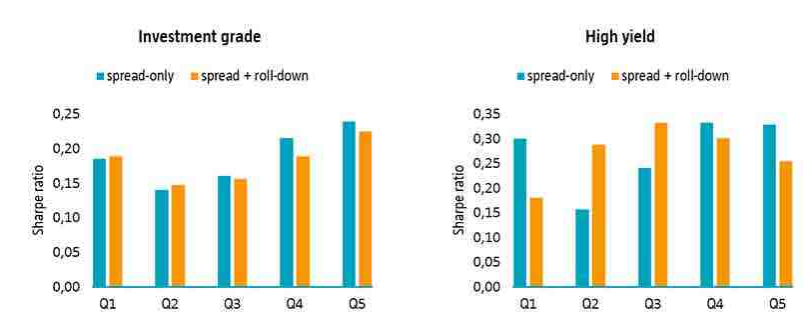As in the equity market, the number of factors is also growing in the corporate bond market. To date, the most common factors in the credit market are size, value, momentum, and low risk. We have also analyzed the quality factor and came to the conclusion that, in the corporate bond market, the quality factor is a natural extension of the low-risk factor: part of quality’s alpha is subsumed by low-risk, but quality still adds value to the factor mix.
クオンツ運用の価値を探求
最先端クオンツ戦略の情報やインサイトを定期的にお届けします。
What is Carry?
In general, carry is defined as the expected return of an asset when market circumstances stay the same. In the credit market, carry can be defined as the credit spread in its simplest form (the additional yield of the corporate bond on top of the Treasury bond yield), or as the credit spread plus the roll-down. The rol-down is the expected return of a bond after rolling down the curve, which is assumed to stay the same. We believe the latter is more complete.
We have evaluated the performance of the carry factor over the period from January 1994 to June 2016. In each month, we sorted bonds on their carry (credit spread + roll-down), divided them into five equally-weighted portfolios, and held them for 12 months. We observed that while the returns generally increase from the lowest carry bonds (Q5) to the highest ones (Q1), their volatilities disperse even more widely and monotonically. As a result, the Sharpe ratio (return per unit of risk) does not increase from Q5 to Q1. This dispersion in volatility is also observable through other risk measures. The bonds with the highest carry in investment grade are those with the highest risk: higher duration, lower credit rating, higher beta, and lower Distance-to-Default (DtD). Similarly in high yield, high carry is characterized by lower rating, higher beta, lower DtD, but lower duration, which indicates a downward-sloping credit spread curve. We thus conclude that high-carry bonds earn not only higher returns, but are also substantially more risky than low-carry bonds.
Figure 1 shows the Sharpe ratios of carry portfolios for investment grade (IG) and high yield (HY). If carry were a successful factor, the Sharpe ratios would be monotonically decreasing as we would move from the highest carry to the lowest carry portfolio. However, in both universes, the highest carry portfolio does not show a superior Sharpe ratio to the other four portfolios. The Sharpe ratio of Q1 in IG is 0.19 and in HY is 0.18. Based on these results, carry should not be considered as a factor by an investor to build a credit portfolio.
Figure 1 | Sharpe ratio of Carry (pick-up + roll-down) quintile portfolios in USD investment grade and high yield

Source: Robeco, Barclays. Sample period: January 1994 - June 2016.
De-risking the Carry factor would make it Value-like
One could argue that the tendency of the carry factor to select more risky bonds could be mitigated by constructing the portfolios in a more risk-neutral manner. However, doing so would make the carry factor very similar to the value factor. Recall that value in the credit market is defined as the credit spread of a bond relative to the underlying risk. By construction, credit spread is the overlapping variable in both the carry and the value factor. If all bonds with the same credit spread would be equally risky, then carry and value would be equal. Thus, if we were to correct the carry factor for more and more risk measures, and construct a risk-neutral carry portfolio, it would become more and more similar to a value portfolio. One could argue that the tendency of the carry factor to select more risky bonds could be mitigated by constructing the portfolios in a more risk-neutral manner. However, doing so would make the carry factor very similar to the value factor. Recall that value in the credit market is defined as the credit spread of a bond relative to the underlying risk. By construction, credit spread is the overlapping variable in both the carry and the value factor. If all bonds with the same credit spread would be equally risky, then carry and value would be equal. Thus, if we were to correct the carry factor for more and more risk measures, and construct a risk-neutral carry portfolio, it would become more and more similar to a value portfolio.
No place in the zoo
In regressions of carry on the credit market, on value, and on value, size, low risk and momentum, we do not find significant alpha, which confirms our previous findings. Moreover, we find economically large (0.82 to 1.06) loadings on value, which are also highly statistically significant. This indicates that the value factor subsumes the carry factor. Therefore, given the existence of the value factor, we conclude that there is no place for a carry factor in the corporate bond factor zoo.
重要事項
当資料は情報提供を目的として、Robeco Institutional Asset Management B.V.が作成した英文資料、もしくはその英文資料をロベコ・ジャパン株式会社が翻訳したものです。資料中の個別の金融商品の売買の勧誘や推奨等を目的とするものではありません。記載された情報は十分信頼できるものであると考えておりますが、その正確性、完全性を保証するものではありません。意見や見通しはあくまで作成日における弊社の判断に基づくものであり、今後予告なしに変更されることがあります。運用状況、市場動向、意見等は、過去の一時点あるいは過去の一定期間についてのものであり、過去の実績は将来の運用成果を保証または示唆するものではありません。また、記載された投資方針・戦略等は全ての投資家の皆様に適合するとは限りません。当資料は法律、税務、会計面での助言の提供を意図するものではありません。 ご契約に際しては、必要に応じ専門家にご相談の上、最終的なご判断はお客様ご自身でなさるようお願い致します。 運用を行う資産の評価額は、組入有価証券等の価格、金融市場の相場や金利等の変動、及び組入有価証券の発行体の財務状況による信用力等の影響を受けて変動します。また、外貨建資産に投資する場合は為替変動の影響も受けます。運用によって生じた損益は、全て投資家の皆様に帰属します。したがって投資元本や一定の運用成果が保証されているものではなく、投資元本を上回る損失を被ることがあります。弊社が行う金融商品取引業に係る手数料または報酬は、締結される契約の種類や契約資産額により異なるため、当資料において記載せず別途ご提示させて頂く場合があります。具体的な手数料または報酬の金額・計算方法につきましては弊社担当者へお問合せください。 当資料及び記載されている情報、商品に関する権利は弊社に帰属します。したがって、弊社の書面による同意なくしてその全部もしくは一部を複製またはその他の方法で配布することはご遠慮ください。 商号等: ロベコ・ジャパン株式会社 金融商品取引業者 関東財務局長(金商)第2780号 加入協会: 一般社団法人 日本投資顧問業協会



















